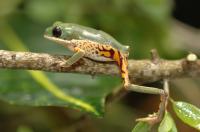
The researchers found that waxed and inactive frogs had about the same metabolic rate as unwaxed, dehydrating frogs. This suggests that waxed frogs are not in a hibernation-like dormant state. In a fascinating new study from the November/December 2006 issue of Physiological and Biochemical Zoology, researchers from the University of Florida explore wiping behaviours in a tree frog that waxes itself, and test whether these frogs become dormant to conserve energy during dehydration. Many amphibians have skin that offers little resistance to evaporative water loss. To compensate, these and some other arboreal frogs secrete lipids and then use an elaborate series of wiping motions to rub the waxy secretions over their entire bodies.
"This self-wiping is a complex behaviour involving the use of all four limbs to stroke or rub all dorsal and ventral body surfaces, including the limbs," explains Nadia A. Gomez (University of Florida, Gainesville) and her coauthors. They continue: "Thus, the animal is protected from dehydration, provided the external film of lipids is not physically disrupted by movements or other disturbance."
Tree frogs characteristically go into a resting posture after wiping themselves, tucking their limbs tightly against or beneath their body and closing their eyes. The researchers found that this series of actions following "waxing" allows tree frogs (Phyllomedusa hypochondrialis) to limit rates of surface evaporation to as little as 4 percent of that from a free water surface in the same environment.
To examine the question of dormancy, the researchers found that waxed and inactive frogs had about the same metabolic rate as unwaxed, dehydrating frogs. This suggests that waxed frogs are not in a hibernation-like dormant state, as was previously thought. (Some frogs, however, showed moderate reductions of metabolic rate as dehydration advanced, suggesting that they might become dormant during, for example, a prolonged drought.)
"Our data do not provide strong evidence that P. hypochondrialis routinely depress metabolic rates and enter a deep dormant state during quiescent behaviours following wiping," explain the authors. "Moreover, quiescent Phyllomedusa remain responsive to [the] presence of insects and eat readily." Source : University of Chicago Press Journals
 Print Article
Print Article Mail to a Friend
Mail to a Friend
